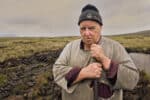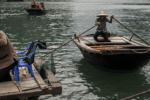Couple folks have asked about Wilma of late, the Neanderthal beauty I shot for last July’s Nat Geo cover story. She has hit stateside evidently, and there are rumors in the hallways of Geographic that they may be preparing a tour for her, kind of nationwide, rock and roll type extravaganza. She’s getting her own bus and and entourage. Evidently since the cover, she’s gone diva and there’s just no dealing with her:-)
Anyway the above pic did not run in the mag, which is cool. Thought I’d show it and discuss a bit, because there is some camerawork here that is really simple, but can appear hard or complex. First thing I always deal with for Geographic is that I do no post on any photo whatsoever. Every frame I shoot goes to my editor, and those frames are straight up raws that come out of the camera. Don’t touch ’em. Don’t go near ’em.
Which means anything I offer to them has to be a field solution. Done deal, in the camera. Fancy or not, lit or not, street shot, portrait, big production–it all goes to the mag just as it came out of the camera. And they are cool with at least receiving things like double exposures. If they run them, it is noted to the reader.
So this is a double that was done in-camera. Programmed a D3 to two exposures, lit each face in turn, and the two exposures became one file. You can see below the rough physical layout of the shot.
The notion sprang from a chance meeting with Marina, the current resident of the land where the new batch of Neanderthal DNA was found. It was that discovery that prompted Geographic’s re-examination of the Neanderthal life style, and the construction of Wilma, our red headed star. (She was exquisitely crafted by the Kennis brothers, who are amazing artists, and great guys to have a beer with.) Marina, a lovely lady, and a modern, slightly red haired female, owns the land that Wilma might have once walked. It got me to thinking.
It lead to us putting black material on the side of a barn, and building this impromptu studio in broad daylight. As you can see, I have identical light sources (shoot through Lastolite all in one umbrellas, and Elinchrom Ranger packs) positioned off the the sides of our subjects, who stand in profile to the lens (70-200mm). The angle of the light is from behind them. (Imagine each of their noses to be 12 o’clock. The lights are at 10 o’clock and 2 o’clock, respectively.) This angle of the approach of the light to each of their faces ensures there is drama to the profile, and serious, quick fall off into shadow on the camera side of their faces. This gives me dark shadow area to play with as I mesh the backs of their heads together. Too much detail back there, and the mix of their hair and their craniums could get confusing and messy.
Ran the lights pretty hard, power wise so I got around 11 to 16 as an f-stop. Two reasons–depth of field across their near eye and nose, and snuffing available light. No stray ambient allowed. Black background. The only thing the camera sees is what you light.
Shooting was pretty simple. Each exposure was made with a single pop from each light. (Each pack was programmed to its’ own Skyport channel.) To enable multiple exposure mode on a D3, you need to go into the shooting menu and program it (up to 10 exposures) for each multiple you shoot. The setting expires after each exposure made, I guess, because the precise, organized engineers of camera like this view photographers as scatter brained and irresponsible, so much so that we would shoot a whole day with multiple exposure engaged if this setting wasn’t programmed to be a one frame at a time deal. Saving us from ourselves, yet again:-)
The sleight of hand, if there is any, is to use the focus cursors for lining up each image. (This is just the way I do it, there are others, to be sure.) I go to focus mode where I have one cursor highlighted in my viewfinder, and I locate it over the near eye. Then, for the second exposure, I toggle the cursor to the corresponding left or right or matching spot where I then put that little red doober right on the near eye of the second image. That way, I know the images will line up. I keep the zoom the same, and in this instance, I had the additional help of Bill Marr, the art director of the Geographic, holding a string, literally, from the edge of my lens shade to the nose of each of the ladies. That way, as I did my little two click dosey doe with the camera, I knew I had the same distance from camera to subject. (Great having an AD like Bill in the field, something that happens only rarely. He’s got a terrific sense of the picture on the page, and he was a shooter himself, so he knows the reality of location work. All hands were welcome on this shoot, ’cause Wilma’s 200 pounds, and we had to carry her a good ways into the woods.)
Only shot a few frames, and I as I mentioned, it was not published in the story. But it remains a good memory of that take, and a worthwhile stab at an impromptu, different, field solution to a problem. The pic of Marina and Wilma that did make it into the mag is below, with Marina playing with Wilma’s hair, and Wilma spectacular in a fur wrap.

More tk….















Another interesting, informative and humorous post. I’ve not tried any double exposures so this post gave me good information. I’ll make it a project for today.
Slowly but surely Joe you’re starting to give some fine lighting advice 🙂 Thanks.
Joe – so do they do any post on your images at Nat Geo? Or do they print the raw image you send them?
Nice post yet again, entertaining to read and informative :).
Thanks a lot.
The guy in the movie HAS to be dutch with that accent, right?
How much artistic freedom do you get in the picture’s you ‘have’ to take? And how do you calculate your fee for an assignment like this, or any assignment for that matter?
Wish I got to do cool assigments like this…
once more… Thanks for sharing!
Squeeker- Occasionally, they’ll mess with overall contrast and such, but even that seems rare. In general, they do so little post that I’ve literally seen some sensor dust on a photo of his in a recent issue…kinda crazy right?
Is the red outfit part of your normal kit?
Thanks Drew! That’s really interesting! I love that they don’t do trickery on the images though. So it’s up to you as the photog to figure out how to actually shoot the image you want.
I guess too that means you gotta clean your sensor often then, huh? LOL
Yup! As Joe replies whenever people ask how often we clean sensors: “whenever Drew has time to”. In “general”, when we’re on the road for a good length of time, I clean sensors twice a week. If we’re doing something nuts and in a dirty environment, I clean them everyday.
So, that’s what assistants are for, huh? lol!
What’s amazing is the colour/detail quality and clean composition of your shots without PP. This is the best lesson I’ve ever had on ‘getting it right in-camera’.
Thank you …
Once again you make me want to grab my camera and run out to try what you’ve described. Thanks for sharing you experience and creativity.
Does Annie realize you run around with some random lingerie? Interesting look into shooting on location. Guess it ain’t all glamour after all. 😉
I see the resemblance,…;-))
Thanks!
Awesome post Joe!!! It amaze me, (like always) to read and watch your stories!!! Another great story for another great book…let me guess; “The Moment it clicks, reloaded”? 🙂
Jakob
(Switzerland)
Thank you, funny and nice Video, and very nice photos … what else 🙂
Fascinating post, devoured every word of it. The Kennis brothers did an amazing job creating such a face.
One question – the lady’s lingerie. Now a recommended flash/flashing item for the camera bag?(Off to search my drawers for a suitable item) 😉
Some I posts, I read the title and immediately go to MP’s blog, but this one…… I read it slowly and happily. Inpsiring, please post more stuff like This!!!!
I’d hire Moose to clean all my equipment and sensors…he seems like he enjoys that process
OMG, that last shot with the nightie. Classic! You should post that one seperately, really. It deserves more exposure.
Joe – Thanks for making my day. What a riot!
Thank you. Great post 🙂
Joe, I got a couple technical questions here:
1) I know you use the focus cursor to align the eyes, but how do you align the “Black gap” between the heads? If teh gap was too large the image would loose some impact, and obviously you don’t want overlapping noggins. Is this just an experience thing, and eyeballing it?
2) Have you ever done this with more of a bust type framing where you get a bit larger view of the profile, say down to the top of teh bicep? Anything you see that would cause a big hick-up in this type of framing?
never thought about that… nice share…
Yet another enjoyable post. One question, what is the black material you used to shoot the double exposure and where can I get it?
So easy, a caveman could do it. 😉